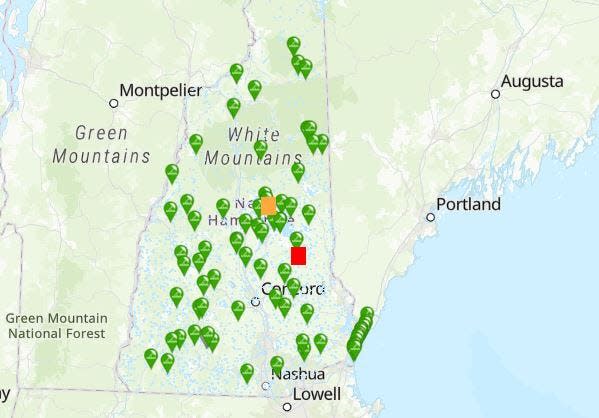Sun, fun, and – fecal bacteria? How to practice ‘Healthy Swimming’ in NH
For many, summer means time to hit the beach. But maybe not any beach, if you don’t want to swim in harmful bacteria.
From late May to early September, New Hampshire’s Beach Inspection Program monitors public beaches for fecal bacteria. And with reports from residents, the state also tracks cyanobacteria blooms, growths that can be dangerous to humans and pets.

Active notices for both types of hazards can be found online through the Healthy Swimming Mapper. As of Tuesday afternoon, the following places were flagged:
Lake Kanasatka in Moultonborough has had a cyanobacteria alert since June 26.
Mill Pond in Alton has had a cyanobacteria warning since June 14.
It’s important to note that just because a body of water doesn’t have a notice listed doesn’t mean it’s in the clear. Beaches aren’t tested every day, and the state relies on residents reporting potential cyanobacteria blooms, which can be done through an online form.
Cyanobacteria alerts mean residents should “be on the watch” for a potential bloom, according to the Department of Environmental Services. Warnings mean that cyanobacteria have been found at a concentration where harmful toxins could be present and threaten public health.
An advisory for fecal bacteria is issued when a water sample contains “levels that exceed the state standard, indicating unhealthy swimming conditions,” according to DES.
The summer months can pose the greatest risks in waters because of the volume of swimmers and the warmer temperatures that can fuel bacteria growth. Here’s what to know heading into a busy swimming holiday.
Fecal bacteria
If the heebie-jeebies aren’t enough to avoid fecally contaminated waters, these bacteria can bring on nausea, vomiting, respiratory illness, and infection, according to the U.S. Environmental Protection Agency.
New Hampshire has monitored oceanside beaches since 2003, sampling them regularly from Memorial Day to Labor Day. Only a subset of freshwater beaches are sampled – typically on a monthly basis – since there are so many of them, according to DES. State parks are prioritized and sometimes sampled more often than that.
This pollution is a nationwide problem. About half of the U.S. beaches surveyed by Environment America, an environmental nonprofit, experienced at least a day of potentially unsafe levels of fecal contamination in 2022.
In 2023, five of 16 coastal beaches in New Hampshire had fecal advisories issued, said Michele Condon, the Beach Inspection Program coordinator. There were 11 total advisories, with some beaches having more than one through the summer.
By comparison, there were 14 total coastal advisories in 2022, 18 in 2021, 10 in 2020, and three in 2019, she said.
There’s always some risk pathogens are in the water, but that risk is greater after heavy rainfall, Condon said. Those significant storm events, which were seen in the 2023 swim season, “can bring in potential stormwater and elevate bacteria levels,” she said.
Outside rainwater, Condon pointed to a number of other sources of fecal contamination: “waterfowl (especially geese), domestic animals, failing septic systems or improperly functioning toilet facilities, or a high density of recreators.”
Cyanobacteria
Cyanobacteria – sometimes called blue-green algae, though they aren’t algae – are often toxic.
They feed on sunlight, warmth, and nutrients, making the summer months an ideal feeding ground. With climate change driving temperatures higher, beachgoers can expect to be greeted by these unpleasant visitors more often.
DES recorded its most blooms ever in 2023, affecting 47 lakes. This reflects a global trend of more frequent blooms, but also greater public awareness leading to more reports.
Cyanobacteria blooms can be blue, green, yellow, white, or brown and look like spilled paint, scum, or blotches.
They often produce toxins that can cause a host of nasty health problems. These include rashes, fevers, headaches, mouth blisters, vomiting, acute liver damage, and more, according to the Department of Environmental Services. They can also sometimes lead to neurological problems like numbness and seizures.
If the water looks suspicious, DES encourages residents to stay out and submit the details to the state so others can be alerted.
You can sign up for waterbody-specific notices and statewide updates online.
This story was originally published by the New Hampshire Bulletin.
This article originally appeared on Portsmouth Herald: Sun, fun, and – fecal bacteria? Practice ‘Healthy Swimming’ in NH
